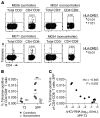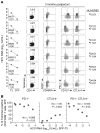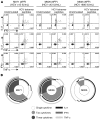CD4+ T cell restoration and control of hepatitis C virus replication after childbirth
- PMID: 31904583
- PMCID: PMC6994162
- DOI: 10.1172/JCI123623
CD4+ T cell restoration and control of hepatitis C virus replication after childbirth
Abstract
Chronic hepatitis C virus (HCV) infection is characterized by persistent high-level viremia and defective cellular immunity, including a lack of functional HCV-specific CD4+ T cells. We previously described an exceptional period of viral control that occurs in some chronically infected women after childbirth. Here, we investigated whether reduced HCV replication after pregnancy is associated with recovery of CD4+ T cell immunity. Class II tetramer analysis revealed significantly greater frequencies of circulating HCV-specific CD4+ T cells at 3 months postpartum in women with concurrent declines in viremia compared with those with stable viremia. These HCV-specific CD4+ T cells had an effector-memory phenotype. Inhibitory coreceptor expression on these cells corresponded to the degree of viral control. Circulating CD4+ T cells produced IL-2 and IFN-γ after HCV antigen stimulation, demonstrating Th1 functionality. These data provide direct evidence that the profound loss of HCV-specific CD4+ T cell help that results in chronic infection is reversible following pregnancy, and this recovery of CD4+ T cells is associated with at least transient control of persistent viral replication.
Keywords: Hepatitis; Immunology; Infectious disease; T cells.
Conflict of interest statement
Figures




Comment in
-
CD4+ T cell responses in human viral infection: lessons from hepatitis C.J Clin Invest. 2020 Feb 3;130(2):595-597. doi: 10.1172/JCI133222. J Clin Invest. 2020. PMID: 31904589 Free PMC article.
Similar articles
-
Follicular T helper cells shape the HCV-specific CD4+ T cell repertoire after virus elimination.J Clin Invest. 2020 Feb 3;130(2):998-1009. doi: 10.1172/JCI129642. J Clin Invest. 2020. PMID: 31697649 Free PMC article. Clinical Trial.
-
Differential CD4(+) and CD8(+) T-cell responsiveness in hepatitis C virus infection.Hepatology. 2001 Jan;33(1):267-76. doi: 10.1053/jhep.2001.21162. Hepatology. 2001. PMID: 11124845
-
Influence of IFNL3 and HLA-DPB1 genotype on postpartum control of hepatitis C virus replication and T-cell recovery.Proc Natl Acad Sci U S A. 2016 Sep 20;113(38):10684-9. doi: 10.1073/pnas.1602337113. Epub 2016 Sep 6. Proc Natl Acad Sci U S A. 2016. PMID: 27601657 Free PMC article.
-
Polyfunctional HCV-specific T-cell responses are associated with effective control of HCV replication.Eur J Immunol. 2008 Oct;38(10):2665-77. doi: 10.1002/eji.200838336. Eur J Immunol. 2008. PMID: 18958874
-
Th1-Biased Hepatitis C Virus-Specific Follicular T Helper-Like Cells Effectively Support B Cells After Antiviral Therapy.Front Immunol. 2021 Sep 30;12:742061. doi: 10.3389/fimmu.2021.742061. eCollection 2021. Front Immunol. 2021. PMID: 34659236 Free PMC article.
Cited by
-
Expression of Senescence Marker TIGIT Identifies Polyfunctional Donor-Reactive CD4+ T Cells Preferentially Lost After Kidney Transplantation.Front Immunol. 2021 Apr 30;12:656846. doi: 10.3389/fimmu.2021.656846. eCollection 2021. Front Immunol. 2021. PMID: 33995373 Free PMC article.
-
Deficiency in CD4 T Cells Leads to Enhanced Postpartum Internal Carotid Artery Vasoconstriction in Mice: The Role of Nitric Oxide.Front Physiol. 2021 Jun 16;12:686429. doi: 10.3389/fphys.2021.686429. eCollection 2021. Front Physiol. 2021. PMID: 34220551 Free PMC article.
-
Hepatitis C Virus Vaccine Research: Time to Put Up or Shut Up.Viruses. 2021 Aug 12;13(8):1596. doi: 10.3390/v13081596. Viruses. 2021. PMID: 34452460 Free PMC article. Review.
-
Adaptive Immune Response against Hepatitis C Virus.Int J Mol Sci. 2020 Aug 6;21(16):5644. doi: 10.3390/ijms21165644. Int J Mol Sci. 2020. PMID: 32781731 Free PMC article. Review.
-
Highly replicating hepatitis C virus variants emerge in immunosuppressed patients causing severe disease.Res Sq [Preprint]. 2025 Jun 9:rs.3.rs-6194507. doi: 10.21203/rs.3.rs-6194507/v1. Res Sq. 2025. PMID: 40585217 Free PMC article. Preprint.
References
-
- Hoofnagle JH. Course and outcome of hepatitis C. Hepatology. 2002;36(5 Suppl 1):S21–S29. - PubMed
Publication types
MeSH terms
Substances
Grants and funding
- T32 HD043003/HD/NICHD NIH HHS/United States
- R01 AI136533/AI/NIAID NIH HHS/United States
- P51 OD011132/OD/NIH HHS/United States
- UL1 TR002733/TR/NCATS NIH HHS/United States
- P51 RR000165/RR/NCRR NIH HHS/United States
- R01 AI096882/AI/NIAID NIH HHS/United States
- R01 AI126890/AI/NIAID NIH HHS/United States
- K12 HD043372/HD/NICHD NIH HHS/United States
- R01 AI124680/AI/NIAID NIH HHS/United States
- R01 AI070101/AI/NIAID NIH HHS/United States
- R56 AI096882/AI/NIAID NIH HHS/United States
- R01 AI105035/AI/NIAID NIH HHS/United States
- U01 AI131314/AI/NIAID NIH HHS/United States
LinkOut - more resources
Full Text Sources
Medical
Molecular Biology Databases
Research Materials

